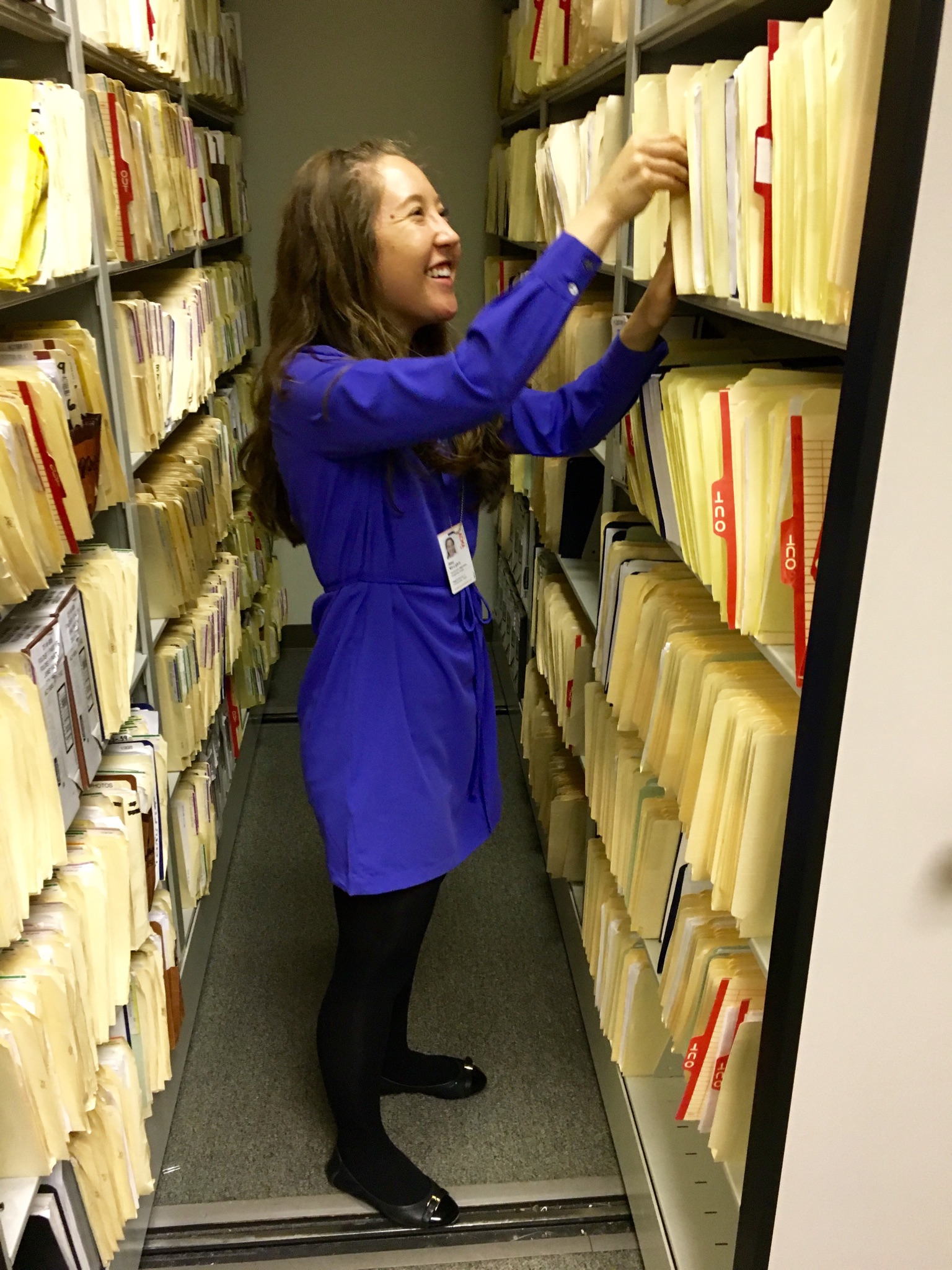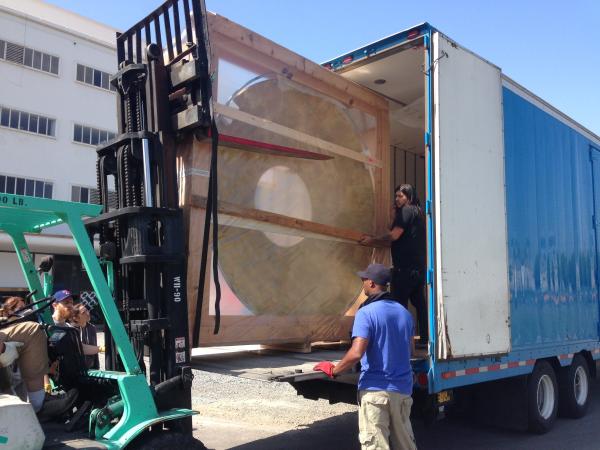Nancy Russell, associate director of registration and collections, shows me the presentation she gave about her department at an all-staff meeting and says, “So, Nordstrom had this ad series where art museum registrars were depicted by print models. 'This model is standing inside an art truck,'" she quotes from her slide, "'wearing four-inch Jimmy Choo heels, just like our registrars do every day when overseeing art being moved in and out of trucks.'” She shakes her head, clicking through the presentation slides. “They don’t. At all. And, in addition to registrars in our department, we have collection managers, art insurance and risk managers, and collection information and digital asset specialists.”
There are six department leads in addition to Nancy, and they file into the room with notebooks and pens in hand, eager to discuss their work. They have a lot to keep track of; with the east campus move-out coming up in a few years in advance of LACMA's new building, they need to inventory the collection. With the museum's robust exhibition schedule, they must keep an eye on contracts.
To begin, when a particular department is looking to put up a new show, what is your role?
Alyssa Morasco, Head of Collection Management: For exhibitions involving permanent collection objects, Suzan [Şengöz, Senior Associate Registrar, Special Projects] or I will receive art viewing requests from curators who want to see the artwork in person to asses if it will be a good fit for their project or exhibition. Once we provide access to the artwork and it is chosen for installation our part is more or less done until the artwork is deinstalled and returned to storage months or even years later. We then address its long term packing and storage needs and make sure its final location is tracked in our database.
Nancy: But for loan shows, it’s more complex. There is a more in-depth process across the board.
Emily Saccenti, Registrar, Exhibitions and Loans: Because we’re working with artwork owned by other people.
Erika Franek, Registrar, Art Insurance, Risk Management, Exhibitions and Loans: It’s a lot of contract negotiations. That’s why, for an exhibition, ideally we have a checklist at least a year out in advance. There’s so much back and forth between our registrars, their registrars, and then we’re also making sure we can meet the requirements. Some museums send requirements, down to what type of paint you can use inside a case.
Emily: I think one of the most complicated things we do is to communicate the requirements to the curators.

So is managing expectations of everyone involved with the show the great challenge of the job?
Emily: Yes, because we’re reading through a contract where the lenders have stated 17 requirements for six different departments.
Amy Wright, Senior Associate Registrar, Permanent Collections: For me, it’s working with curatorial to understand all the acquisition terms, our relationship with the donor or artist, and to make sure all key negotiations are listed in the acquisition agreement. Especially for complicated acquisitions such as a joint acquisition with another institution or acquisitions of time-based media or installation artworks.
So you’re kind of the “organizers” of the museum.
Erika: We are organizers, that’s what all of us do in various forms, but it’s behind-the-scenes.
Nancy: Except for on the floor in exhibitions, when the show is being installed. The exhibition registrars create the installation and deinstallation schedule. They coordinate when the shipments are coming in with the couriers and the unpacking, condition checking, and installation schedule takes place.
Do you ever get anxious that you’re touching priceless artworks?
Alyssa: I’ll never forget my first week on the job, at my first museum, back east. I had to help my boss hang a Van Gogh, and having that starstruck moment where I was like, I am the only person holding this piece up. If I drop it I’ve ruined art. But, fortunately, I’ve had really good training as far as how to safely handle artwork, so it takes a lot of the guesswork and surprises out of it. You can definitely get into a routine where you’re comfortable because you’re around it all day long. But you always have to keep in the back of your mind, be humble, watch what you’re doing, and really pay attention. It’s not like this oh my god feeling—it’s like oh, where am I going to fit this giant Ed Moses piece that just came down? It almost becomes more of a logistical [puzzle].
Suzan: My big concern is how heavy it is.
Alyssa: She gets the big stuff.
Suzan: Is my forklift going to pick it up? And how big is it? How many people need to move it? But besides that, I think over the years, handling art, working with collections management, and art handler folk who handle the art, you get comfortable, you kind of forget about the value because it’s all has great value.
What is the greatest misconception about who a registrar is and what a registrar does?
Erika: I think there’s a certain kind of person who’s drawn to a job that involves a lot of multitasking, organizing, Excel charts, and color coding. There is a certain kind of person who loves a list. And that is us.
Nancy: And checking that list off.
Erika: You have to have that eye for detail and the ability to catch details coming on in multiple places at the same time. But having that big picture and enjoying that level of getting into something and wrangling a situation is what drives us to it.
Emily: I think the field as a whole has really become more respected and sort of project management-focused. And part of the team. In the past, the registrars were much more secretarial and focused only on the files.
Alyssa: I think for collection management at least, long-term preservation museum-wide has picked up more traction. It’s much more visible. Even the trend in visible storage is an obvious indication of people wanting to look behind the scenes. So I don’t think it’s as tucked away as it has been in the past.
Nancy: And the art collection database feeding data to collections online makes the art available to the world.
Maja Clark, Head of Collection Information and Digital Assets: More and more, there’s a dream to have museum collections databases more interconnected. More people just expect a Google-like search for anything. And there’s more movement toward planning not only for the museum itself but how it’s going to communicate and fit into the world wide web of museum collection information.
What would you consider your biggest victory as a department?
Maja: I think just getting more known and this moment that has brought us together. That people might want to know about us...the complexity and evolving expertise required of behind the scenes work is having its day.
Emily: I think we can also be proud of LACMA’s collections and registration department’s influence in our field around the world. I think we’re hearing more and more positive feedback about the procedures we’ve established. People are constantly contacting us with questions and I think that’s a really big victory for all of us.
Nancy: And we’ve been greatly assisting in the mission of the museum, managing the challenge of the increased program. In the last decade, the acquisition rate has doubled and we’ve nearly tripled the number of exhibitions.
Erika: That’s also something for us to be proud of, that our ambitious exhibition schedule has meant we’ve learned how to travel exhibitions to China, the Middle East, Korea, Chile, and South America. We are pushing that envelope further and further. It’s something we’ve risen to every time.



